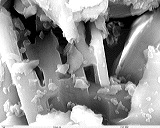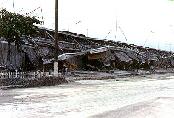|
| Michigan Tech Home | Department of Geological Engineering & Sciences | Remote Sensing Institute | MTU Volcanoes Page | Volcanic Clouds Web Site | Total Ozone Mapping Spectrometer (TOMS) | Volcanic Ash Advisory Centers (VAAC) | Smithsonian Institution | Alaska Volcano Observatory | |
|
|
Overview:
Science Issues |
ASHFALL
FORECASTS
Forecasting ashfall is a difficult but very important task that involves the understanding of many disciplines. Ash particles produced during an eruption can remain in the atmosphere for days and have been attributed to many health and machinery problems. Why are forecasts of ashfall important?The volcanic ash that is created during an eruption can be hazardous to one's health. Fine ash can remain airborne for long periods of time and upon falling out, are easily re-suspended by wind or human activities such as driving. Fine ash that is inhaled can lead to a number of serious health effects including silicosis of the lungs, respiratory problems such as asthma and fluorosis. Many governments have incorporated an upper limit of the
concentration of fine particles an individual should inhale before it becomes
a health risk. In the Ash also presents a problem to machinery
and structures. The average weight of ash 1 inch deep is 10 lbs per
square foot. Significant ashfall can therefore easily collapse
structures. How is Ashfall Forecasted?For the most part, geologists have a strong understanding of how large particles fall from an ash cloud. Typically, these particles fall out in a matter of hours. The behavior of fine ash particles however is poorly understood. These particles can remain in the atmosphere for days but frequently fall out surprisingly quickly due to mechanisms that are poorly understood. Ashfall can be predicted using information about the
eruption, the erupted particles and local wind vectors at a variety of
altitudes. The amount of time a particle takes to falls depends on the
height at which it was erupted and its terminal velocity in the
atmosphere. The particle falls from altitudes above the vent and The horizontal winds are responsible for carrying the ash particles from the volcano. The distance that the particle can travel is related to the amount of time that the particle falls and the strength and direction of the atmospheric winds. The wind vectors are typically measured using meteorological balloons called radiosondes and generally change at various altitudes. Several trajectory
models can predict the location of an ash cloud in time and space. Future
Needs In order to better predict the fallout of volcanic ash a better understanding of how ash actually falls out from the atmosphere is needed. Factors that are assumed in the presently used forecasting models do not accurately describe the physical characteristics of ash particles and do not account for particles sticking to each other and then falling faster than predicted. |
|
| Michigan Tech Home | Department of Geological Engineering &
Sciences | Remote Sensing Institute
| MTU Volcanoes Page | Volcanic Clouds Web Site
| Total Ozone Mapping Spectrometer
(TOMS) | Volcanic Ash Advisory
Centers (VAAC) | Smithsonian
Institution | Alaska Volcano
Observatory | |
|
|
|
|



